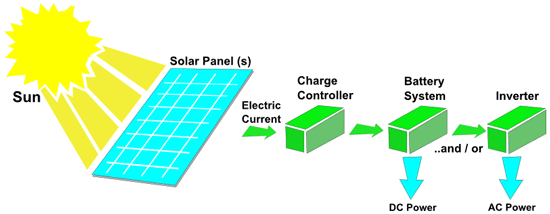Energy harvesting from renewable, clean sources of electric power is poised for take-off, and the main booster engines are firing. Electronic systems designers looking to power a remote sensor are more frequently turning to solar energy, available in vibration, thermal, RF, and solar energy. The reason: Photovoltaic conversion provides the highest power density of any energy harvesting source about 10 µW/cm² from indoor lighting and 10 mW/cm² from outdoors.

Like all energy-harvesting sources solar requires efficient power management because the availability of light can be highly variable; energy output from a solar panel depends on several factors, including the type of panel, location, sun tracking ability, time of year and day (obviously sunlight input is zero at night). Typical efficiency is about 10%.
Solar-energy-harvesting designs require efficient circuitry capable of handling energy input, power output and controlling an energy storage device with low self-discharge, to provide sufficient power for the application, using thin-film battery devices, supercapacitors or both.
For design engineers striving to get the most out of a solar panel, it’s important to also consider that solar panels operate at maximum efficiency at a particular point on their VI curve called the maximum power point (MPP). Although the solar panel itself may be fixed and not tracking the sun Maximum Power Point Tracking (MPPT) controllers are used to get the most power out of the solar cells and are typically implemented in a dedicated microcontroller-based system. Mouser offers a good selection of these components, which can be found on Mouser.com at the Solar Product Knowledge Center (www.mouser.com/solar_technology/) as well as at the MPPT Products for Solar Micro Inverters (micro inverters convert dc from a single solar panel to ac. The electric power from several micro inverters is combined and fed into an existing electrical grid; for more information visit the Mouser Web site).
Engineers can take advantage of a broad range of design techniques and integrated devices to achieve their specific energy harvesting targets. Development kits provide an effective method to rapidly gain experience designing these systems. Mouser provides a number of useful Energy Harvesting Development Kits. Let’s briefly look at two of these, the Texas Instruments eZ430-RF2500-SEH and Microchip Technology’s DV164133 XLP 16-bit Energy Harvesting Development Kit.
The eZ430-RF2500-SEH is a complete solar energy-harvesting development kit from Texas Instruments that helps create a perpetually powered wireless sensor network. Based on the low-power Texas Instruments MSP430 microcontroller, the solar energy harvester module includes a solar panel optimized for operating indoors under low-intensity fluorescent light. This provides enough power to run a wireless sensor application with no additional batteries. Inputs are also available for external energy harvesters such as thermal, piezoelectric, or another solar panel. The Texas Instruments kit includes a USB debugging interface that allows for real-time, in-system debugging and programming for the MSP430 and is also the interface to transfer data to a PC from a wireless system.
The Microchip Technology DV164133 XLP 16-bit Energy Harvesting Development Kit is another excellent development platform for realizing energy-harvesting applications and enabling rapid prototyping of low power apps. It is based on Microchip’s PIC24F16KA102 MCU with nanoWatt XLP Technology (sleep currents below 20 nA; run currents down to 50 μA/MHz) and Cymbet’s EVAL-08 Solar Energy Harvester. The MCU offers the capability of adding PICtail daughter boards for the rapid evaluation of a wide variety of system functions, including ZigBee, SD memory cards, and more.
The Cymbet EnerChip EH Eval-08 Energy Harvesting Board harvests solar energy that is then stored in EnerChip solid-state, rechargeable energy storage devices. The EnerChips act as an energy buffer that stores energy while the application is sleeping or has no light available to harvest. The batteries can be recharged thousands of times. They also have a very low self discharge, which is vital for a no-power, energy-harvesting system.
For more information, visit the Mouser Solar Technology Product Knowledge Center at www.mouser.com/solar_technology/. ■
Advertisement
Learn more about Mouser Electronics





